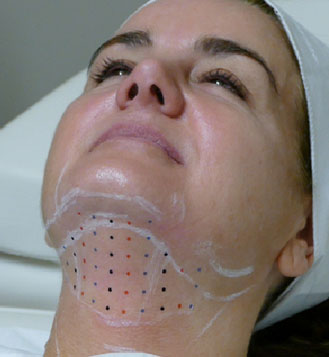
Few accomplishments are as rewarding as waking up in the morning and hitting your target weight. You've worked hard to drop those unwanted pounds all year long, and you deserve a huge round of applause for what you've accomplished. However, if you're like many men and women, getting the sleek, sculpted body you crave is easier said than done. You've got pockets of unwanted fat around your abdomen, thighs, chin, and other areas - fat that just won't go away, despite diet and exercise.
Wouldn't it be nice to just freeze that fat away and forget all about your love handles?
At Southern Cosmetic Laser, our new, revolutionary fat-freezing treatment can help you achieve the toned look you've been dreaming of. That's right - we're talking about literally freezing the unwanted fat off your problem areas without invasive surgeries or extended downtime.
This amazing treatment is called CoolSculpting, and it's the world's leading non-invasive fat reduction procedure. It's specifically designed for people already at their desired weight who want to push past that plateau for real body sculpting results. If you're tired of seeing that excess belly fat, saggy skin, or double chin, CoolSculpting is the procedure for you. Southern Cosmetic Laser offers a wide range of the newest technologies to target fat reduction, skin tightening, facial and body remodeling, body toning, and cellulite reduction.

Our Services
Services Area

What is CoolSculpting?

CoolSculpting is an FDA-approved procedure that has undeniable results. With CoolSculpting, you can permanently get rid of your muffin top, fat around your flanks, and more, all from the comfort and convenience of the Southern Cosmetic Laser office.
Technically known as cryolipolysis, CoolSculpting has the ability to reduce the number of fat cells in targeted areas between 20 and 25%. This unique technology uses controlled cooling to freeze and eliminate fat with minimal recovery time. No needles, no scalpels, no liposuction. Just real results provided by a licensed, experienced professional.
While CoolSculpting helps eliminate fat cells in your body, it doesn't harm the surrounding skin and muscles. Instead, it treats fat that is directly under the skin, also called subcutaneous fat. Since CoolSculpting doesn't target visceral fat deposits, this treatment works best for men and women who are approaching or already at their desired weight.
CoolSculpting is approved by the FDA to help reduce fat in the following areas:
- Flanks
- Outer Thighs
- Upper Arms
- Inner Thighs
- Chin
- Back
- Belly and Abdomen
How Does CoolSculpting Work?

CoolSculpting results are noticeable, proven, and long-lasting, helping you look your best and feel great from every angle. This exciting procedure works because fat cells freeze at higher temps than other tissues. As such, CoolSculpting delivers controlled, targeted cooling to do away with unwanted fat underneath your skin. These fat cells are essentially frozen or crystallized and eventually die. With time, your body will process that fat and will eliminate the dead cells, leaving behind a more sculpted physique.
Here are some quick CoolSculpting facts at a glance, so you have a better idea of why this fat cell elimination treatment is so popular:
- There is no prep time required for CoolSculpting from Southern Cosmetic Laser.
- Patients can expect some very minor discomfort during the procedure. Many patients report no discomfort at all.
- There is little-to-no downtime needed after your CoolSculpting procedure is complete.
- It may take up to 12-16 weeks to see your final results.
- This procedure eliminates fat permanently!

Southern Cosmetic Laser's CoolSculpting Procedure

Our CoolSculpting procedure is crafted around your comfort, with one-on-one attention in a relaxing atmosphere. It all starts with a detailed assessment, which you will complete prior to your treatment. This assessment will help us better understand your goals and desires, so we can freeze away the stubborn fat from the areas that matter most.
Typical CoolSculpting appointments take about an hour per area, though that time varies with each patient. Because our CoolSculpting applicators use a vacuum system to help with placement, you may feel a pulling sensation in the targeted area. Once placement is complete, we get to work on freezing your fat.
Before treatment, your skin is prepped with an alcohol wipe. A gel pad is then placed on your treatment area to help protect your skin. From there, a cold sensation is delivered through our applicators, which are designed for specific body parts.
Because there is no sedation involved with CoolSculpting, we encourage you to kick back, relax, and watch a little TV. If you prefer, you can also read or use your phone to check your favorite social media sites. Our friendly, experienced CoolSculpting technicians strive to keep you as comfy as possible during this quick treatment. When it's over, you can resume normal activities as soon as you like - there's no recovery or downtime to worry about!


Top CoolSculpting Treatment Areas

CoolSculpting procedures are perhaps best known for eliminating stubborn belly fat, giving the patient a desirable, contoured tummy. However, this treatment is also very effective on other areas of your body:
CoolSculpting for Your Double Chin
While neck fat usually goes hand-in-hand with weight gain, symptoms like double chins can appear even if you're not overweight. CoolSculpting helps solve neck fat problems by eliminating fat cells in the area below your chin, giving you a slim, youthful appearance.

CoolSculpting for Unwanted Belly Fat
Many men and women begin CoolSculpting treatments to destroy fat around the abdomen or midsection. CoolSculpting does so by freezing stubborn subcutaneous fat in the abdominal region, resulting in a trimmed-up tummy. Remember, CoolSculpting does not treat visceral fat, or the fatty tissue surrounding the organs in your abdomen.

CoolSculpting for Your Back
Back fat is a serious problem for many people in the U.S. This includes the upper back (where fat rolls over the bra), the mid-back (near the waist), and the lower back (where fat bulges over the beltline). Back fat can be hard to tone, but with CoolSculpting from Southern Cosmetic Laser in Isle of Palms, it's more than possible.

CoolSculpting for Your Upper Arms
When it comes to stubborn fat, your upper arms are often the most difficult areas to treat. If you are constantly trying to hide your upper arms from friends and family, CoolSculpting is an excellent option to help overcome your insecurity.

CoolSculpting for Your Love Handles
Sometimes called saddlebags or flanks, love handles are the flabby areas that protrude from your hips. Love handles are often caused by fat retention over long periods of time. They can appear very pronounced in tight clothing, leading to feelings of embarrassment. Common factors that contribute to love handles are age, slow metabolism, hormones, and diets high in sugars and fats. With Southern Cosmetic Laser's CoolSculpting, patients leave behind stubborn love handles, helping them achieve a slimmer, more fit appearance.

CoolSculpting for Your Thighs
If you are in good shape but suffer from chafing or discomfort due to fatty thighs, your solution could be at Southern Cosmetic Laser. Our technicians can help freeze away inner thigh fat, so you feel proud to wear skirts, shorts, and bikinis.


Questions About CoolSculpting? We've Got Answers
Q: Does CoolSculpting really work?
A: Yes! Southern Cosmetic Laser wouldn't be one of the most trusted providers of the treatment if it didn't work. According to recent statistics, CoolSculpting treatments can reduce fat reduction by as much as 25% in the affected area. Contact our office today for your initial consultation, where our team will advise you on how many treatments you need to meet your goals.
Q: How much does CoolSculpting cost?
A: Pricing varies depending on the areas you focus on and how many sessions you need in order to reach your goals. Our team will craft a custom treatment plan specific to you during your initial CoolSculpting consultation.
Q: How quickly will I see results?
A: Many patients can see results as soon as three weeks after their first CoolSculpting procedure in Isle of Palms. As your body continues to dispose of crystallized fat cells, you can see even more changes with time.
Q: Does CoolSculpting eliminate cellulite?
A: CoolSculpting is designed for fat reduction. However, it may help contribute to cellulite reduction in specific treatment areas. There are currently no FDA clearances for cellulite reduction with CoolSculpting. However, our office offers incredible treatments like Inmode Evolve to reduce the appearance of cellulite and trim, tighten, and tone your skin.
Q: Why should I choose Southern Cosmetic Laser for CoolSculpting in Isle of Palms?
A: Southern Cosmetic Laser is a CoolSculpting certified practice and has completed advanced training at the CoolSculpting University. With a highly-trained staff of medical professionals, we're one of the leading providers of CoolSculpting in South Carolina. We know that peace of mind is precious these days. That's why we're committed to you and your body contouring transformation every step of the way.
Popular Treatments That Complement CoolSculpting

We are a full-service practice offering Medical Aesthetics and Cosmetic Dermatology services. As such, Southern Cosmetic Laser has several innovative treatments that complement your CoolSculpting procedure. Whether you're looking to tighten up that turkey neck or say goodbye to cellulite, we've got a custom treatment option waiting for you.


Cellulite Treatment with Sentient Sculpt
Southern Cosmetic Laser is Isle of Palms's first medical aesthetics practice to offer Sentient Sculpt. This exciting new product reduces fat, remodels skin tissue, and regenerates skin collagen, leaving your skin tight and smooth.
Using microwave technology, Sentient Sculpt uses up to 80% of the energy generated to penetrate fat under your skin. This process destroys fat cells and the fibrous bands that cause dimples, or cellulite. The remaining 20% of energy is used on the upper layers of your skin, tightening and contracting it to improve its overall appearance.
Sentient Sculpt benefits include:
- Long-Lasting Results
- Improved Skin Laxity
- Effective Skin Tightening & Fat Reduction
- Fat Cells Permanently Destroyed
- Younger Looking Skin
- Minimal Discomfort
- Built-In Cooling for Maximum Comfort
Contact Southern Cosmetic Laser today to learn more about the benefits of Sentient Sculpt and how it can be paired with CoolSculpting treatments.

Kybella for Your Double Chin
If you're ready to kiss that double chin goodbye, Kybella could be the solution you need. Kybella is a treatment that deoxycholic acid that breaks down fat cells when injected into the treatment area. It provides noticeable results for improved chin profile.
Kybella Benefits Include:
- Permanent destruction of fat cells
- Quick treatment process
- Patients may see results in 2 to 4 treatments

Facial Remodeling with Inmode Evoke
Inmode Evoke is the first and only FDA-approved, non-invasive product for facial remodeling treatment. Evoke offers tightening and lifting for facial rejuvenation and can help you achieve a more defined neck and jawline.
The Evoke Intelligence System regulates temperature and sense impedance every millisecond, providing remarkable results. Using proven bipolar radiofrequency energy, Evoke sub-dermally remodels your facial tissue. The Evoke technology offers precise, consistent power to achieve optimal results.

Tite, Trim, & Tone with Inmode Evolve
This advanced, state-of-the-art Thermal Body Contouring Technology helps to trim, tighten, & tone your skin at the same time. Evolve's cutting-edge tech can destroy fat, reduce cellulite, and tighten skin. The result? A newfound, youthful appearance and feel. This treatment is perfect for your mommy makeover, eliminating muffin tops, sculpting abs, and addressing fat around your thighs, belly, arms, legs, hips, and knees.
Benefits of Inmode Evolve include:
- Tone and Tighten Skin
- Eliminate Fat Cells
- Reduce Crepey Skin
- Reduce Saggy Skin
- Collagen Stimulation for Improved Skin Elasticity
- Smooth Over Stubborn Fat Pockets
- Even Out and Reduce Skin Irregularities
Contact Southern Cosmetic Laser today to learn more about the benefits of Inmode Evolve and how it can be paired with CoolSculpting treatments.

Discover CoolSculpting Precision and Unlimited Beauty with Southern Cosmetic Laser
When it comes to unmatched patient care and body contouring services in Isle of Palms, no other practice comes close to Southern Cosmetic Laser. We pour passion into every service we offer, from non-surgical fat cell freezing to laser hair removal. If you're looking to make a change for the better this year, we're here to make your wishes a reality. Contact our office today to learn more about the stunning benefits of CoolSculpting technology. Before you know it, you'll be excited to show off that new bathing suit or bikini on the beach.
 843-277-2240
843-277-2240
Free Consultation
Latest News in Isle of Palms, SC
New waterfront park coming to Isle of Palms this year
Autumn Kleinhttps://www.live5news.com/2024/02/05/new-waterfront-park-coming-isle-palms-this-year/
ISLE OF PALMS, S.C. (WCSC) - The Isle of Palms City Council in 2020 voted to make additions to the marina area of the island and that project is officially slated to be completed this year.The project included the addition of a public dock, a boardwalk and a waterfront park and greenspace. The boardwalk and public dock have been completed, and, as of Jan. 11, the construction contract for the waterfront park and greenspace was officially confirmed.The waterfront park will cover the 300 by 25 foot wide area along the marina faci...
ISLE OF PALMS, S.C. (WCSC) - The Isle of Palms City Council in 2020 voted to make additions to the marina area of the island and that project is officially slated to be completed this year.
The project included the addition of a public dock, a boardwalk and a waterfront park and greenspace. The boardwalk and public dock have been completed, and, as of Jan. 11, the construction contract for the waterfront park and greenspace was officially confirmed.
The waterfront park will cover the 300 by 25 foot wide area along the marina facing the Intracoastal Waterway. There will be a 6-foot wide concrete walkway. The park will include a large lawn area with lush planting.
They plan to include a series of benches along the waterfront walkway so residents can enjoy views of the water and boating activities. There are plans for a circular seat wall near the public dock that would create an entrance to the dock area.
They plan to include a kayak storage area and a kayak launch area. There will be golf cart parking available as well as bicycle parking areas.
All of these plans did require collaboration and participation from the marina manager and restaurant tenants. Scott Toole, the general manager of the Outpost, a nearby restaurant, says he is very excited for this addition to the area.
“I think that it’s an added benefit to the island, to the residents, everybody, to have a space and to use the dock. Kayak launching is a big thing that I think people will take advantage of.” he says. “It’s really going to help make this area kind of a place of interest for people, sort of a destination so to speak, for people to be able to get some food, get some drink, watch the water and use the dock that’s right there.”
Toole says they very recently renovated the Outpost and he’s excited to see this new project bring more people to the area. He says he feels like this area of Isle of Palms is often overlooked as it is a little ways away from the main beach.
“We’ve kind of joked that it’s a small corner of the island and so, anything that’s bringing people down this direction is good for everybody. We’re excited to see this project take place,” he says.
The project is currently slated to be completed by May of this year. To provide City Council your input on this project you can click here.
Copyright 2024 WCSC. All rights reserved.
Isle of Palms voters to decide on new short-term rental limits
David Slade dslade@postandcourier.comhttps://www.postandcourier.com/politics/local_politics/isle-of-palms-sc-to-vote-on-limiting-short-term-rentals/article_b4f8c3d4-6d39-11ee-aeb9-4b7ea0878ca0.html
ISLE OF PALMS — A bumper crop of yard signs has sprouted across this barrier island as voters prepare for a referendum Nov. 7 that could limit short-term rental licenses.It's the latest skirmish in a much broader fight over the future of these sorts of vacation usages that's been playing out across South Carolina.“If nothing else, we are keeping the sign business afloat," said Mayor Phillip Pounds.Isle of Palms is among the communities on the frontlines — all places where high demand from vacatione...
ISLE OF PALMS — A bumper crop of yard signs has sprouted across this barrier island as voters prepare for a referendum Nov. 7 that could limit short-term rental licenses.
It's the latest skirmish in a much broader fight over the future of these sorts of vacation usages that's been playing out across South Carolina.
“If nothing else, we are keeping the sign business afloat," said Mayor Phillip Pounds.
Isle of Palms is among the communities on the frontlines — all places where high demand from vacationers fuels the short-term rental business. Charleston, Mount Pleasant, Folly Beach and Beaufort limit such rentals; Sullivan's Island prohibits them; Myrtle Beach doesn't allow new ones in residential neighborhoods.
The Isle of Palms referendum calls for imposing a 1,600 cap on short-term rental licenses for investors and second-home owners. There would continue to be no cap for homes that are the owners' primary residence.
It's about preserving the island's quality of life, say supporters. More than 30 percent of the city's registered voters signed a petition to get the referendum on the ballot.
“We have a growing number of short-term rental licenses in residential communities," said Randy Bell, a former councilman working with pro-referendum group Preserve Isle of Palms Now. "We are trying to maintain the one-third, one-third, one-third split between full-time residents, second homes and rental properties."
Opponents say it's really about property rights and property values. An investment property or second home could be harder to sell, and worth less, if there's no certainty it could be used for short-term rentals.
“What are we trying to solve?" said Hugh Swingle, an island resident whose family business is Palm Blvd Vacation Rentals. "We just don’t see that there’s an actual problem.”
The city had issued 1,625 licenses to property owners who are not full-time residents as of early October, and if the referendum were to pass, no new ones would be available until the number drops below 1,600.
"Obviously, we don't think it's good," said Ryan Buckhannon, president of the Isle of Palms Chamber of Commerce. He's a former councilman who owns an investment property licensed for short-term rentals.
Supporters and detractors of the referendum have set up websites, put out yard signs and sent mailings.
Isle of Palms United opposes the cap and claims on its website, iopunited.com, that taxes "have to" go up and property values will go down if the referendum were to pass. That group and others claim property values plunged 25 to 30 percent on Folly Beach after a February voter referendum capped short-term licenses there at 800.
Charleston Trident Association of Realtors data gives reason to question such claims. According to CTAR data, the median price of a house sold on Folly Beach in 2023 through September was down 14.9 percent, but the median price of a condo or townhouse sold there was up 28.2 percent.
“There’s no basis for the claim that property values will plummet by 40 percent," said Bell.
Swingle, who is affiliated with Isle of Palms United, said a cap could be a big problem for people who want to sell a property in the years ahead.
“If there were a cap in place, and you own one of those tiny condos and you went to sell it, you could have a really hard time without a (short-term rental) license," he said.
Swingle expects the vote to be close.
Preserve Isle of Palms Now supports the referendum, which the group says on preserveiop.org is about keeping the island a great place to live and preserving its residential nature by not allowing unlimited short-term rentals.
"IOP residents are either already experiencing or can foresee future problems with water and sewer capacity, traffic & parking congestion, environmental impacts, and the availability of long-term rental housing," the group's website says.
The Palm Republic, an organization created by former Isle of Palms Mayor Jimmy Carroll and current Councilman Blair Hahn, has also created programming opposing the referendum. Hahn even alleged in a YouTube video that referendum supporters have talked about driving down property values in order to get deals on real estate.
The island has long been known as a place to rent a house or condo at the beach, or to have a second home that could be rented out for much of the year.
Full-time residents own about a third of the homes, and they can rent out those homes for up to 72 days each year if they have a short-term rental license. As of early October, 184 owner-occupied homes on Isle of Palms had short-term rental licenses.
“It’s a vacation spot, and has always been a rental community, to some extent," said Pounds, the mayor, who declined to say how he will vote. "We have 1,400 condos, give or take."
That's a lot on an island with about 4,400 residents. Most of those condos are in Wild Dunes or former hotels in the commercial area along the beachfront, and most are for rent. Many single-family homes across the island are also licensed for short-term renters.
While full-time residents are the minority of property owners on the island, they are the only people who can vote.
The referendum is on the ballot because of a petition signed by 1,173 of the city's 3,740 registered voters. That petition put a short-term rental ordinance before City Council, and after the council declined to pass that ordinance in July, it became a ballot referendum.
If the referendum were to pass, the ordinance would take effect.
The Isle of Palms yes/no referendum question is: "Shall the City of Isle of Palms limit the investment short term rental business licenses to a maximum of 1,600?"
Across the marsh in neighboring Mount Pleasant, which has more than 94,000 residents, just 400 short-term rental permits are allowed.
Supporters of short-term rentals hope state lawmakers will act to prohibit and invalidate any local restrictions in 2024. A measure aimed at limiting local governments' ability to restrain short-term rentals failed earlier this year.
Folly Beach earlier this year imposed a short-term rental cap following a referendum. Folly Beach has fewer than half as many residences as Isle of Palms, and the town now has an 800-license limit on short-term rentals.
Isle of Palms would have 1,600, plus as many licenses as full-time residents want for their homes, if the referendum were to pass. Residents will also choose four City Council members in the election, from eight candidates.
Get the latest political news from The Post and Courier in your inbox.
Reach David Slade at 843-937-5552. Follow him on Twitter @DSladeNews.
Whose beach is it? Isle of Palms homeowner, state at odds over unauthorized 'sea wall'
Anna Sharpe asharpe@postandcourier.comhttps://www.postandcourier.com/news/illegal-seawall-isle-of-palms-iop-dhec-rom-reddy/article_f7ec7734-c6b3-11ee-a134-8b6c56b6ff22.html
ISLE OF PALMS — Record tides from an unexpected nor'easter in December ripped away several feet of sand on this barrier island, exposing an unauthorized, clandestine wall in front of a beachfront home near Breach Inlet.The wall's unveiling also spawned a power struggle between the state Department of Health and Environmental Control and the Ocean Boulevard homeowner, with the two at odds over property rights and protecting the diminishing shoreline....
ISLE OF PALMS — Record tides from an unexpected nor'easter in December ripped away several feet of sand on this barrier island, exposing an unauthorized, clandestine wall in front of a beachfront home near Breach Inlet.
The wall's unveiling also spawned a power struggle between the state Department of Health and Environmental Control and the Ocean Boulevard homeowner, with the two at odds over property rights and protecting the diminishing shoreline.
SC Climate and Environment News
This is all playing out on a sandy beach where waves are clawing closer to multi-million dollar homes amid heavy erosion caused by storms and high tides.
The home at the center of the dispute belongs to Rom Reddy, owner of the multimedia local news outlet MyLo News. After taking a beating from Hurricane Idalia last year, Reddy said he installed the wall as a erosion control barrier and covered it with 30 feet of sand.
The December nor'easter washed away the sand, uncovering the bulwark.
While performing post-storm damage assessments, DHEC became aware of the structure.
Some call it a sea wall, which the state defines as a retaining wall designed to withstand wave forces. Reddy maintains his wall isn't a sea wall, as it was never meant to be exposed to the ocean. It was meant to be buried beneath the sand to protect his home's foundation and yard, he said.
"This keeps my yard stable and keeps it from moving around, which is what a retaining wall does. If we have a catastrophic event, it gives my property some protection, although a very nominal level, because it's not meant to be ocean facing," Reddy said.
Reddy said the nor'easter left the wall tilting and unstable, prompting him to have it rebuilt. In response, DHEC sent a cease-and-desist letter in January to halt the construction.
Cease he did not. Construction on the wall continues to move full steam ahead and shows no sign of slowing down.
Reddy said it is his right as a property owner to protect his home. The area landward of the setback line is his to do with as he pleases, he said, citing South Carolina's Coastal Tidelands and Wetlands Act.
Not so, according to DHEC's division of Ocean and Coastal Resource Management.
The sand in front of Reddy's property is considered a critical area, the agency said, and any alteration of a critical area requires permits from OCRM, even critical areas that are landward of the jurisdictional setback.
DHEC spokesperson Laura Renwick said the agency regularly issues permits for work in these areas, though it is unlikely Reddy's wall would have been approved.
"Since erosion control structures and devices such as the one identified at this property have been banned per state law since 1988, this structure would not have been permitted," Renwick said.
Today's Top Headlines
Isle of Palms officials said they are aware of the structure, which violates a city ordinance prohibiting hard erosion control measures like sea walls, bulkheads and revetments. But in the case of Reddy's unauthorized structure, the city said its hands are tied. Jurisdiction of that area, and much of the island's critical areas, fall under DHEC, said Mayor Phillip Pounds.
"In this particular case, the OCRM has claimed jurisdiction, so that takes the city out of the mix, and it is up to them to enforce the state-level rules. We are relying on the state to enforce their rules that prevent structures like this being built per their cease-and-desist orders," Pounds said.
Judges in two cases in recent years have sided with homeowners who built walls or placed sandbags along eroding sections of the South Carolina coast.
While Reddy is facing pushback from DHEC, some of his neighbors are behind him. Paul Jorgensen, who owns the property adjacent to Reddy, said he doesn't love what is being erected next door, but he understands his neighbor's mindset. Working with the city and the state to get approval for protective measures has left him feeling frustrated.
"The city and the state have been utterly horrible at handling the situation. Not only have they been utterly horrible at managing, they won't even let us help ourselves," Jorgensen said.
Jorgensen said the preventative measures the city does take on aren't enough.
Ongoing restoration and protection efforts on the island include continuing sand scraping and sandbag placements on the island that began under an emergency order following Hurricane Idalia in September. City Council gave the efforts a boost in October, allotting $1.25 million to continue sand scraping along the beaches to rebuild the dunes. Council also budgeted $250,000 for installing sandbags on properties within 20 feet of erosion areas.
"The city and the state are not doing nearly enough, and, in fact, are preventing homeowners from protecting our own property," Jorgensen said.
South Carolina hasn't allowed structures like Reddy is building since enacting the Beachfront Management Act in 1988, citing a "false sense of security" the measures give to beachfront property owners while simultaneously aiding in further erosion.
Structures like sea walls block the ability of a wave to break naturally, pushing its force onto adjacent properties. The energy bounces back off of the wall, pulling the sand and eroding the beach on the seaward side. Emily Cedzo, director of conservation programs and policy for the Coastal Conservation League, said softer measures for preventing erosion, like sand fencing and larger restoration projects, are ideal for protecting beaches.
"Those are really the ideal ways to manage a beach responsibly so that it can provide good protection for private properties, but also public access and wildlife habitat," Cedzo said.
With multiple cease-and-desist directives, DHEC could begin to dole out fines or penalties.
"When DHEC identifies violations of applicable state laws or regulations, the agency has the authority to initiate an enforcement process that may result in the issuing of a civil penalty to the responsible party, among other actions," Renwick said.
Some think it's time for DHEC to take action.
"I think DHEC is going to have to move forward with enforcement. I don't know what their process or timeline looks like, but I think it's clear that they've already tried to communicate with the property owner," Cedzo said. "I know that several residents on the Isle of Palms are really concerned about it and continue sending reports."
Reddy said the cease-and-desist directives from DHEC won't deter him.
"They have to go in front of a judge and prove to the judge that we're, in fact, breaking the law. And we're ready for that," Reddy said.
Reach Anna Sharpe at 843-806-6790.
Isle of Palms noise ordinance up for discussion after questions from businesses
Meredith Blairhttps://www.live5news.com/2024/02/16/isle-palms-noise-ordinance-up-discussion-after-questions-businesses/
ISLE OF PALMS, S.C. (WCSC) - Big changes could be coming to the noise ordinance on Isle of Palms as city leaders hope to make the rules more clear.The city’s noise ordinance currently doesn’t list specific limits. A proposal would establish set decibel levels based on the time and day of the week as well as the area:Isle of Palms business owners got the chance to see the numbers and ask questions on Friday.“We want them to understand that they have a voice, we want to hear from them,” Police Chief...
ISLE OF PALMS, S.C. (WCSC) - Big changes could be coming to the noise ordinance on Isle of Palms as city leaders hope to make the rules more clear.
The city’s noise ordinance currently doesn’t list specific limits. A proposal would establish set decibel levels based on the time and day of the week as well as the area:
Isle of Palms business owners got the chance to see the numbers and ask questions on Friday.
“We want them to understand that they have a voice, we want to hear from them,” Police Chief Kevin Cornett said. “Anything that is going to impact businesses we want them to be able to come to us and say what they think about it.”
One area resident, who only identified himself as Paul, says the noise ordinance needs to have a balance.
“Obviously, late at night you don’t want people making a lot of noise walking up and down the streets while residents are trying to go to bed, but at the same time this is a vacation spot, so you have to have a little bit on leeway for people to enjoy themselves but also be respectful,” he said.
Cornett says they’re working to find a solution that will work for businesses and residents and increase livability for everyone.
Cornette says noise is a hot topic on the island and he values feedback on this from both residents and business owners.
“Everybody is very much invested in this conversation,” Cornett said. “The city council is taking it very seriously and they are going around and talking to people to get their input. So, I think they are doing a great job on making sure voices are heard so that when we get the final project it’s fair and something that will work for everybody.”
Officers use a calibrated decibel reader when called out to a noise complaint.
“That’s how we determine if it’s a violation and then we would take other factors into account like background noise to keep the realistic approach to is as well,” Cornett said.
The public safety committee has to create a final draft before it will head to the city council for two separate readings.
Copyright 2024 WCSC. All rights reserved.
DHEC takes Isle of Palms seawall fight to court
Erin Morganhttps://www.counton2.com/news/the-investigators/dhec-takes-isle-of-palms-seawall-fight-to-court/
ISLE OF PALMS, S.C. (WCBD) — The ongoing conflict between the South Carolina Dept. of Health and Environmental Control (DHEC) and a homeowner on the Isle of Palms has now gone to court.After storms in August and December 2023 led to significant beach erosion, Rom Reddy, an oceanfront property owner, took matters into his own hands by building a wall to prot...
ISLE OF PALMS, S.C. (WCBD) — The ongoing conflict between the South Carolina Dept. of Health and Environmental Control (DHEC) and a homeowner on the Isle of Palms has now gone to court.
After storms in August and December 2023 led to significant beach erosion, Rom Reddy, an oceanfront property owner, took matters into his own hands by building a wall to protect his property near Breach Inlet from beach erosion.
However, earlier this month, DHEC officials told News 2 that anything built on critical areas of the coast, like beaches, needs a permit. They added that after investigating Reddy’s wall, they issued Reddy and the contractor cease and desist directives because it was an “unauthorized structure.”
However, DHEC officials said Reddy’s work on the wall continued even after the directives were issued.
Now, attorneys for DHEC have taken the battle to court, filing a temporary restraining order (TRO) and petition for injunctive relief in South Carolina Administrative Law Court.
“Due to the Respondents’ egregious disregard of OCRM’s Notice to Comply and the two Cease and Desist Directives, the Department has no adequate remedy at law other than to seek judicial intervention to compel the Respondents to immediately cease their unauthorized actions in the critical area,” the court filing reads.
This week, Reddy’s lawyers responded to the agency’s court filings requesting that the judge deny the motion for a TRO and petition for injunctive relief.
Reddy’s lawyers argue that his wall is not located in a critical area and that DHEC lacks the subject matter jurisdiction to issue the cease and desist in the first place. “In issuing these directives, Petitioner [DHEC] is unilaterally and unfairly extending its jurisdiction to convert private property into a public beach,” the court filing reads.
They also say that the cease and desist is a moot point because no ongoing work was being done when DHEC filed the TRO. “Petitioner [DHEC] seeks a TRO and injunctive relief to allegedly stop Respondents from ‘continuing to install a hard erosion control structure adjacent'” to the Property. As of the date of this filing, no ongoing work is being done on the Property: therefore, Petitioner’s cease-and-desist directives are moot,” they wrote.
Reddy’s attorneys also filed a countersuit against DHEC and the city of Isle of Palms with several claims, including that they violated Reddy’s constitutional rights. “DHEC has engaged in actions and inactions that have converted Respondents· private property into a public beach without justcompensation in violation of the South Carolina Constitution and the United States Constitution,” they argue.
Reddy’s attorneys also claim that DHEC and Isle of Palms leaders failed to maintain the beach near his property. In the court filing, they write, “DHEC also fails to note that prior to the Idalia storm damage, in June of 2023, Respondents sent various letters and notices of the vulnerability of the Isle of Palms properties due to improper beach renourishment by Isle of Palms and Petitioner [DHEC].”
Reddy’s lawyers also requested the case be moved to circuit court for a jury trial.
News 2 reached out to Reddy for comment about the court filings. In a statement, he said “state jurisdiction over private property is set by the SC General Assembly and last approved in 2018. DHEC, a state agency has illegally taken upon itself the task of claiming jurisdiction property by property based on a single storm. This provides Government unlimited and varying jurisdiction over private land. This is unconstitutional and will not stand”.
When News 2 asked DHEC for comment, an agency spokesperson responded “DHEC doesn’t comment on pending litigation. DHEC’s Petition For Injunctive Relief and Motion for TRO and Preliminary Injunction explain in detail the Department’s position.”
The Chief Administrative Law Judge has set a hearing date on April 18 for DHEC’s motions. Both Reddy and DHEC will present their evidence at this time.
Disclaimer:

